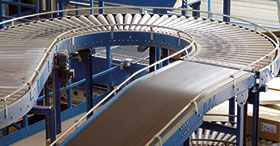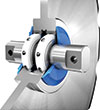

An emphasis on the hygiene element of the design of equipment can play an important role in controlling the safety of manufactured food products. “However, applying this too broadly without focusing specifically on the hygienic design of the components part of the system, can potentially risk the spread of bacteria trapped within bearings,” says Davide Zanghi, the engineer responsible for the Hygienic Design Office in SKF.
Hygienic design considers specifically how problems such as corrosion, lubricant leakage, cleaning and self-drying could adversely affect food safety – and applies design principles to solve the problem. In essence, it is a design philosophy applied through dedicated and specific rules. Just as ergonomic design pays close attention to the physical needs of product users, hygienic design has a sharp focus on preventing issues of contamination.
Design principles – a view on bearing components
In general, EHEDG guidelines consider bearings an easy place to trap food particles and water and therefore these are seen as potential breeding grounds for harbouring bacteria. The advice is: keep bearings well away from food product contact areas.

This is very much the case with recent guidelines on hygienic design of belt conveyors for the food industry, where EHEDG addresses two of the major challenges in safe food production: how to avoid contamination of food through inadequately designed processing equipment, and how to improve food safety without raising operating costs for cleaning and production hygiene. Even if lots of attention goes on systems design and major components such as belts, bearings and bearing units consistently have a low profile within the overall hygienic system design.
However, even if not in direct contact with the food zone, bearings are often in the proximity of food product and with high pressure water or dry cleaning regimes they pose the risk that bacteria – if present – can get airborne and potentially contaminate the food product.
Hygienic design principles
In order to minimise the risk of contamination, designing bearings with hygienic principles in mind is a key consideration. One of the most important principles underpinning hygienic design is the ability to clean effectively. This may be easy to understand, but it is often difficult to achieve in practice for bearings and bearing units. For a start, the products should be made from non-corrosive and non-porous materials, such as stainless steel, or composites and with shapes that are cleanable and allow self-draining. Bearing units should have filled bases to prevent cavities where germs may fester.
In general, materials used such as elastomers, composites and grease, should be compliant with food safety directives and regulations. In all instances, potential of grease leakage onto the food product during operation must be avoided.
Ideally, bearing units should have effective end covers that prevent process contaminants and cleaning fluids from entering the bearing units cavity and, at the same time, allow for frequent visual inspection. Other relevant areas include:
• Avoid metal-to-metal contacts in between unit components and in between units and attaching surfaces.
• Avoid re-lubrication as much as possible.
• Achieve high service life despite the demanding operating and cleaning regimes.
Hygienic design applies to food production and packaging machinery in its entirety. But dealing specifically with one of the most problematic components – bearings – can only help to improve the overall risk strategy.
For more information contact Samantha Joubert, SKF South Africa, +27 (0)11 821 3500, [email protected], www.skf.co.za
| Tel: | +27 11 821 3500 |
| Email: | [email protected] |
| www: | www.skf.co.za |
| Articles: | More information and articles about SKF South Africa |

© Technews Publishing (Pty) Ltd | All Rights Reserved